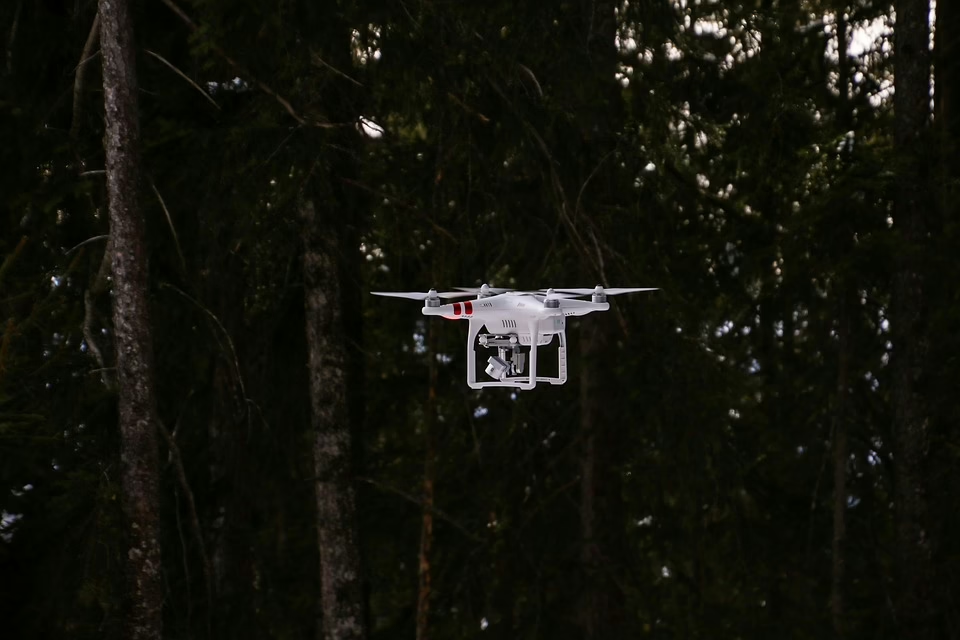ad_1]
New Mechatronics Design Pushes Drone Performance Boundaries
Abstract:
Unmanned Aerial Vehicles (UAVs), commonly known as drones, have experienced exponential growth in adoption across various industries, from agriculture and construction to surveillance and package delivery. This proliferation is driven by their versatility, cost-effectiveness, and ability to access remote or dangerous environments. However, the performance of drones remains constrained by limitations in their structural design, actuation mechanisms, sensor integration, and control systems. This article explores recent advancements in mechatronics design that are pushing the boundaries of drone performance. We delve into innovative approaches in lightweight materials, advanced propulsion systems, novel actuation methods, integrated sensor suites, and intelligent control algorithms. Through a comprehensive review of cutting-edge research and development, we highlight how these mechatronics innovations are enhancing drone capabilities in terms of flight time, payload capacity, maneuverability, stability, autonomy, and overall operational efficiency. Finally, we discuss the challenges and opportunities that lie ahead in the continued evolution of mechatronics design for next-generation drones.
Keywords: Drones, UAVs, Mechatronics, Design, Performance, Propulsion, Actuation, Sensors, Control, Autonomy.
1. Introduction
The field of Unmanned Aerial Vehicles (UAVs), more commonly known as drones, has witnessed a dramatic transformation in recent years, transitioning from niche military applications to widespread adoption across diverse civilian sectors. This burgeoning interest stems from the unique capabilities that drones offer, including their ability to perform tasks in hazardous environments, access remote locations, and gather data with unparalleled efficiency and cost-effectiveness. As such, drones are increasingly being employed in areas such as aerial photography and videography, infrastructure inspection, precision agriculture, search and rescue operations, environmental monitoring, and even package delivery [1].
The core of any successful drone design lies in its mechatronics system – a multidisciplinary field that integrates mechanical engineering, electronics, computer science, and control engineering to create intelligent and automated systems. In the context of drones, mechatronics principles are applied to design and optimize various components, including the airframe, propulsion system, actuation mechanisms, sensor suite, and control algorithms. These elements must work in synergy to achieve desired performance characteristics, such as flight stability, maneuverability, payload capacity, flight time, and autonomous operation [2].
Despite the significant progress made in drone technology, several limitations still hinder their widespread adoption and limit their potential applications. For example, battery technology remains a bottleneck, limiting flight endurance and payload capacity. Traditional actuation mechanisms, such as electric motors and servos, often lack the precision and efficiency required for complex maneuvers and stable flight. Furthermore, the integration of advanced sensors and sophisticated control algorithms is crucial for achieving autonomous operation in challenging environments.
This article focuses on recent advancements in mechatronics design that are addressing these challenges and pushing the performance boundaries of drones. We explore innovative approaches in lightweight materials, advanced propulsion systems, novel actuation methods, integrated sensor suites, and intelligent control algorithms. By examining these key areas, we aim to provide a comprehensive overview of how mechatronics innovation is driving the evolution of drone technology and enabling new applications.
2. Lightweight Materials for Enhanced Flight Efficiency
One of the most critical factors affecting drone performance is weight. Reducing the overall weight of the drone directly translates into increased flight time, improved payload capacity, and enhanced maneuverability. Traditionally, drones were constructed using relatively heavy materials such as aluminum alloys and steel. However, recent advancements in materials science have led to the development of lightweight alternatives that offer comparable or even superior strength-to-weight ratios [3].
2.1. Carbon Fiber Composites
Carbon fiber reinforced polymers (CFRPs) have emerged as a dominant material in high-performance drone construction. Carbon fiber is exceptionally strong and stiff while being significantly lighter than traditional metals. By embedding carbon fibers in a polymer matrix, manufacturers can create composite structures with tailored properties, optimizing strength, stiffness, and weight distribution. CFRPs are particularly well-suited for drone airframes, propellers, and other structural components that require high strength and stiffness [4].
2.2. Magnesium Alloys
Magnesium alloys are another class of lightweight materials gaining traction in drone manufacturing. Magnesium is the lightest structural metal, offering significant weight savings compared to aluminum. While magnesium alloys have lower strength than some other materials, they can be effectively used in non-structural components or in conjunction with other lightweight materials to optimize the overall weight of the drone. Furthermore, magnesium alloys exhibit excellent damping properties, which can help reduce vibrations and improve flight stability [5].
2.3. Polymer Foams
Polymer foams, such as expanded polystyrene (EPS) and expanded polypropylene (EPP), are lightweight and inexpensive materials commonly used in drone construction, particularly for hobbyist and entry-level models. While polymer foams lack the strength and stiffness of CFRPs and magnesium alloys, they offer excellent impact resistance and can be easily molded into complex shapes. These materials are often used for drone bodies, wings, and other aerodynamic surfaces [6].
2.4. Additive Manufacturing and Material Optimization
Additive manufacturing, also known as 3D printing, is revolutionizing the way drones are designed and manufactured. This technology allows for the creation of complex geometries and intricate internal structures that would be impossible to produce using traditional manufacturing methods. By leveraging additive manufacturing, designers can optimize the material distribution within a drone component, placing material only where it is needed for structural integrity and minimizing weight in non-critical areas. Furthermore, additive manufacturing enables the use of advanced lightweight materials, such as carbon fiber reinforced composites and titanium alloys, in a more cost-effective manner [7].
3. Advanced Propulsion Systems for Enhanced Efficiency and Performance
The propulsion system is a critical component of any drone, responsible for generating the thrust required for lift, maneuverability, and flight stability. Traditional drone propulsion systems typically consist of electric motors, propellers, and electronic speed controllers (ESCs). However, recent advancements in motor design, propeller aerodynamics, and ESC technology are significantly improving the efficiency and performance of drone propulsion systems [8].
3.1. Brushless DC Motors
Brushless DC (BLDC) motors have become the standard for drone propulsion due to their high efficiency, high power density, and long lifespan. Unlike traditional brushed motors, BLDC motors do not have mechanical brushes, which eliminates friction and reduces wear, resulting in higher efficiency and longer service life. Furthermore, BLDC motors offer precise speed and torque control, which is essential for achieving stable and responsive flight [9].
3.2. Advanced Propeller Designs
Propeller design plays a crucial role in determining the efficiency and thrust generated by the propulsion system. Traditional propellers are often designed using simple aerodynamic principles. However, recent advancements in computational fluid dynamics (CFD) and advanced manufacturing techniques have enabled the development of propellers with more complex geometries and optimized airfoil profiles. These advanced propeller designs can significantly improve thrust, reduce drag, and minimize noise [10].
3.3. Electronic Speed Controllers (ESCs)
Electronic speed controllers (ESCs) are responsible for regulating the speed of the electric motors by controlling the power supplied to them. Modern ESCs utilize sophisticated microcontrollers and advanced control algorithms to provide precise motor control, high efficiency, and rapid response times. Furthermore, some ESCs incorporate features such as regenerative braking, which allows the motor to act as a generator, converting kinetic energy back into electrical energy and improving overall efficiency [11].
3.4. Hybrid Propulsion Systems
While electric propulsion systems are dominant in the drone industry, hybrid propulsion systems that combine electric motors with internal combustion engines or fuel cells are gaining traction for applications that require extended flight times and higher payload capacities. Hybrid systems offer the benefits of both electric and conventional propulsion, providing high efficiency at lower power levels and high power output when needed. For example, a drone with a hybrid propulsion system could use an electric motor for takeoff and landing, and then switch to an internal combustion engine for cruising, significantly extending its flight time [12].
3.5. Ducted Fans
Ducted fans offer several advantages over traditional propellers, including improved safety, reduced noise, and increased thrust at lower speeds. A ducted fan consists of a propeller enclosed within a duct or shroud, which helps to channel airflow and increase thrust efficiency. Ducted fans are particularly well-suited for drones operating in confined spaces or near people, as the duct provides protection for the propeller and reduces the risk of injury [13].
4. Novel Actuation Methods for Enhanced Maneuverability and Control
In addition to propulsion, actuation mechanisms play a crucial role in controlling the attitude and movement of drones. Traditional drones typically rely on conventional control surfaces, such as ailerons, elevators, and rudders, or on differential thrust from multiple rotors to achieve desired flight maneuvers. However, recent advancements in actuation technology are enabling the development of more agile and maneuverable drones [14].
4.1. Vector Thrust Systems
Vector thrust systems allow drones to precisely control the direction of thrust generated by their propulsion systems. This can be achieved by tilting the rotors or nozzles of the propulsion system, enabling the drone to move in any direction without changing its orientation. Vector thrust systems offer significant advantages in terms of maneuverability and agility, allowing drones to perform complex maneuvers such as hovering, strafing, and quick turns [15].
4.2. Articulated Rotors
Articulated rotors are similar to those used in helicopters, allowing each rotor blade to independently pitch, flap, and lead/lag. This enables the drone to actively control the aerodynamic forces generated by each rotor blade, providing precise control over its attitude and movement. Articulated rotors offer significant improvements in stability, maneuverability, and control authority, particularly in gusty or turbulent conditions [16].
4.3. Morphing Wings
Morphing wings allow drones to dynamically change the shape of their wings during flight to optimize aerodynamic performance for different flight conditions. This can be achieved by using flexible materials, shape memory alloys, or actuators to change the wing’s camber, span, or sweep angle. Morphing wings can significantly improve drone efficiency, maneuverability, and stability, particularly in changing wind conditions [17].
4.4. Fluidic Actuation
Fluidic actuation utilizes the principles of fluid mechanics to control the flow of air over aerodynamic surfaces, enabling precise control over lift, drag, and pitching moment. Fluidic actuators can be implemented using small jets of air or synthetic jets, which are created by oscillating diaphragms. Fluidic actuation offers several advantages over traditional actuation methods, including reduced weight, lower power consumption, and faster response times [18].
5. Integrated Sensor Suites for Enhanced Perception and Autonomy
Autonomous navigation and decision-making require drones to have a comprehensive understanding of their environment. This is achieved through the integration of advanced sensor suites that provide information about the drone’s position, orientation, velocity, and surrounding environment. Recent advancements in sensor technology are enabling the development of drones with enhanced perception and autonomy [19].
5.1. Global Positioning System (GPS)
The Global Positioning System (GPS) is a satellite-based navigation system that provides drones with accurate position and velocity information. GPS is essential for autonomous navigation and waypoint tracking, allowing drones to follow pre-programmed flight paths and return to home automatically. However, GPS signals can be unreliable in urban environments or indoors, where signal blockage and multipath interference can occur [20].
5.2. Inertial Measurement Unit (IMU)
An Inertial Measurement Unit (IMU) consists of accelerometers and gyroscopes that measure the drone’s acceleration and angular velocity. IMUs are used to estimate the drone’s orientation and position, and are particularly important for stabilizing the drone during flight and for providing feedback to the control system. IMUs are also used in conjunction with GPS to provide more accurate and reliable navigation information, particularly in environments where GPS signals are weak or unavailable [21].
5.3. Computer Vision
Computer vision enables drones to “see” their environment using cameras and image processing algorithms. Computer vision can be used for a variety of tasks, including obstacle avoidance, object recognition, terrain mapping, and visual navigation. Recent advancements in deep learning and artificial intelligence have significantly improved the performance of computer vision algorithms, enabling drones to perform more complex tasks autonomously [22].
5.4. Light Detection and Ranging (LiDAR)
Light Detection and Ranging (LiDAR) is a remote sensing technology that uses laser beams to create detailed 3D maps of the environment. LiDAR is particularly useful for applications such as terrain mapping, infrastructure inspection, and environmental monitoring. LiDAR sensors are typically more expensive and heavier than cameras, but they provide significantly more accurate and detailed information about the environment [23].
5.5. Ultrasonic Sensors
Ultrasonic sensors use sound waves to measure the distance to nearby objects. These sensors are commonly used for obstacle avoidance and altitude control, particularly at low altitudes. Ultrasonic sensors are relatively inexpensive and lightweight, but their range is limited and they can be affected by noise and environmental conditions [24].
6. Intelligent Control Algorithms for Enhanced Stability and Autonomy
The control system is the brain of the drone, responsible for processing sensor data, making decisions, and controlling the actuators to achieve desired flight maneuvers. Recent advancements in control theory and artificial intelligence have led to the development of intelligent control algorithms that enable drones to fly more stably, efficiently, and autonomously [25].
6.1. Proportional-Integral-Derivative (PID) Control
Proportional-Integral-Derivative (PID) control is a classic control algorithm that is widely used in drone control systems. PID controllers adjust the control output based on the error between the desired setpoint and the actual measured value. PID controllers are relatively simple to implement and tune, but they may not perform well in highly nonlinear or time-varying systems [26].
6.2. Model Predictive Control (MPC)
Model Predictive Control (MPC) is an advanced control algorithm that uses a mathematical model of the drone to predict its future behavior and optimize the control inputs over a finite time horizon. MPC can handle complex constraints and nonlinearities, and is particularly well-suited for trajectory tracking and obstacle avoidance [27].
6.3. Reinforcement Learning
Reinforcement learning (RL) is a type of machine learning that enables drones to learn optimal control policies through trial and error. RL algorithms can be used to train drones to perform complex tasks, such as autonomous navigation, obstacle avoidance, and aggressive maneuvering. RL is particularly useful for learning control policies in environments where a precise mathematical model of the drone is not available [28].
6.4. Sensor Fusion
Sensor fusion is the process of combining data from multiple sensors to obtain a more accurate and reliable estimate of the drone’s state and environment. Sensor fusion algorithms can be used to combine data from GPS, IMU, cameras, LiDAR, and other sensors to improve the accuracy of position, orientation, and velocity estimates. Sensor fusion is essential for achieving robust and reliable autonomous navigation [29].
6.5. Swarm Intelligence
Swarm intelligence is a type of artificial intelligence that enables multiple drones to coordinate their actions and work together as a team. Swarm intelligence algorithms can be used to coordinate the movement of multiple drones for tasks such as search and rescue, environmental monitoring, and infrastructure inspection [30].
7. Challenges and Opportunities
While the advancements in mechatronics design discussed above have significantly improved drone performance, several challenges remain in the continued evolution of drone technology [31].
7.1. Battery Technology
Battery technology remains a significant bottleneck in drone performance. Current lithium-ion batteries offer limited energy density, which restricts flight time and payload capacity. Furthermore, battery charging times can be lengthy, and battery life can be affected by temperature and usage conditions. Future research and development efforts should focus on developing batteries with higher energy density, faster charging times, and longer lifespan. Alternative energy storage technologies, such as solid-state batteries, lithium-sulfur batteries, and fuel cells, are also promising avenues for future research [32].
7.2. Regulatory Frameworks
The regulatory frameworks governing drone operations are still evolving. Regulations regarding drone flight altitude, airspace restrictions, and remote identification are still being developed and implemented in many countries. Clear and consistent regulatory frameworks are essential for promoting the safe and responsible use of drones and for fostering innovation in the drone industry [33].
7.3. Cybersecurity
Drones are vulnerable to cybersecurity threats, such as hacking and data breaches. Protecting drone systems from cyberattacks is essential for ensuring the safety and security of drone operations. Future research and development efforts should focus on developing robust cybersecurity measures for drones, including encryption, authentication, and intrusion detection systems [34].
7.4. Public Perception
Public perception of drones can be influenced by concerns about privacy, safety, and noise pollution. Addressing these concerns through education and outreach is essential for gaining public acceptance of drone technology. Furthermore, developing drones that are quieter and less intrusive can help alleviate public concerns [35].
7.5. Opportunities for Future Research and Development
Despite these challenges, there are numerous opportunities for future research and development in the field of mechatronics design for drones. Some promising areas include:
- Artificial intelligence and machine learning: Developing more sophisticated AI and machine learning algorithms for autonomous navigation, decision-making, and task planning.
- Advanced sensor technology: Developing smaller, lighter, and more accurate sensors for environmental perception and situational awareness.
- New materials and manufacturing techniques: Exploring new materials and manufacturing techniques for creating lightweight, strong, and durable drone structures.
- Energy harvesting: Developing energy harvesting technologies to supplement battery power and extend flight time.
- Human-drone interaction: Developing intuitive and user-friendly interfaces for controlling and interacting with drones.
- Swarm robotics: Developing algorithms and technologies for coordinating the actions of large swarms of drones.
8. Conclusion
Mechatronics design is playing a pivotal role in pushing the performance boundaries of drones. Innovations in lightweight materials, advanced propulsion systems, novel actuation methods, integrated sensor suites, and intelligent control algorithms are enabling drones to fly higher, faster, longer, and more autonomously. As drone technology continues to evolve, mechatronics engineering will remain at the forefront of innovation, driving the development of next-generation drones with enhanced capabilities and expanded applications. While challenges remain in areas such as battery technology, regulatory frameworks, cybersecurity, and public perception, the opportunities for future research and development are vast. By addressing these challenges and capitalizing on these opportunities, we can unlock the full potential of drone technology and create a future where drones play an increasingly important role in our lives. [36]
References
[1] Floreano, D., & Wood, R. J. (2015). Science, technology and the future of small autonomous drones. Nature, 521(7553), 460-466. [2] Beard, R. W., & McLain, T. W. (2012). Small unmanned aircraft: Theory and practice. Princeton University Press. [3] Agarwal, B. D., & Broutman, L. J. (2006). Analysis and performance of fiber composites. John Wiley & Sons. [4] Campbell, F. C. (2010). Structural composite materials. ASM International. [5] Polmear, I. J., StJohn, D. H., Nie, J. F., & Qian, M. (2017). Light alloys: From traditional alloys to nanocrystals. Butterworth-Heinemann. [6] Gibson, L. J., & Ashby, M. F. (1997). Cellular solids: Structure and properties. Cambridge university press. [7] Gibson, I., Rosen, D. W., & Stucker, B. (2014). Additive manufacturing technologies: 3D printing, rapid prototyping, and direct digital manufacturing. Springer. [8] Anderson, J. D. (2017). Fundamentals of aerodynamics. McGraw-Hill Education. [9] Kenjo, T., & Sugawara, A. (1993). Stepping motors and servo drives. Oxford university press. [10] Selig, M. S. (1996). Propeller aerodynamic design. UIUC Airfoil Data Site. [11] Mohan, N., Undeland, T. M., & Robbins, W. P. (2003). Power electronics: converters, applications, and design. John Wiley & Sons. [12] Bradley, T. H., & Moffitt, J. A. (2011). Gas turbine hybrid electric propulsion for aircraft. Journal of Aircraft, 48(1), 325-336. [13] Fathi, M., Saeed, F., & Kasaiezadeh, A. (2016). Aerodynamic characteristics of ducted fans: A review. Progress in Aerospace Sciences, 84, 1-19. [14] Etkin, B., & Reid, L. D. (1996). Dynamics of flight: stability and control. John Wiley & Sons. [15] Maciejewski, A. A. (2011). Kinematic redundancy for robotic manipulation. Springer Science & Business Media. [16] Leishman, J. G. (2006). Principles of helicopter aerodynamics. Cambridge university press. [17] Barbarino, S., Bilgen, O., Ajaj, R. M., Friswell, M. I., & Inman, D. J. (2011). A review of morphing aircraft. Journal of Intelligent Material Systems and Structures, 22(9), 875-890. [18] Amitay, M., Honohan, A. M., Nadarajah, P., & Glezer, A. (2001). Aerodynamic flow control over a pitching airfoil using synthetic jet actuators. Journal of Aircraft, 38(5), 767-770. [19] Siciliano, B., Khatib, O., & Kröger, T. (2016). Springer handbook of robotics. Springer. [20] Kaplan, E. D., & Hegarty, C. J. (2017). Understanding GPS: principles and applications. Artech house. [21] Titterton, D. H., & Weston, J. L. (2004). Strapdown inertial navigation technology. IET. [22] Forsyth, D. A., & Ponce, J. (2011). Computer vision: a modern approach. Pearson Education. [23] Shan, J., & Toth, C. K. (Eds.). (2018). Topographic laser ranging and scanning: principles and processing. CRC press. [24] Fraden, J. (2010). Handbook of modern sensors: physics, designs, and applications. Springer Science & Business Media. [25] Åström, K. J., & Murray, R. M. (2010). Feedback systems: an introduction for scientists and engineers. Princeton university press. [26] Bennett, S. (2011). A history of control engineering, 1930-1955. IET. [27] Rawlings, J. B., Mayne, D. Q., & Diehl, M. (2017). Model predictive control: theory, computation, and design. Nob Hill Publishing, LLC. [28] Sutton, R. S., & Barto, A. G. (2018). Reinforcement learning: an introduction. MIT press. [29] Durrant-Whyte, H., & Bailey, T. (2006). Simultaneous localization and mapping: part I. IEEE robotics & automation magazine, 13(2), 99-110. [30] Bonabeau, E., Dorigo, M., & Theraulaz, G. (1999). Swarm intelligence: from natural to artificial systems. Oxford university press. [31] Shakhatreh, H., Sawalmeh, A. H., Al-Fuqaha, A., Dou, Z., Aldosari, H., Mohammed, H., & Khreishah, A. (2019). Unmanned aerial vehicles (UAVs): A survey on civil applications and key research challenges. IEEE Access, 7, 48572-48634. [32] Tarascon, J. M., & Armand, M. (2001). Issues and challenges facing rechargeable lithium batteries. Nature, 414(6861), 359-367. [33] Clothier, R., Walker, R., Lachlan, K., Fulton, B., & Morrison, A. (2015). Risk assessment and regulatory development for unmanned aircraft systems (UAS) operations. Journal of Unmanned Vehicle Systems, 3(3), 140-156. [34] Yan, Q., Yu, F. R., Sun, Y., Li, Z., & Wang, Y. (2019). Cybersecurity challenges and solutions for unmanned aerial vehicle-aided communications. IEEE Wireless Communications, 26(2), 80-87. [35] Jeziorek, A., Napieralski, A., & Kamiński, P. (2017). The influence of unmanned aerial vehicles (UAV) noise on the natural environment: A review. Environmental Science and Pollution Research, 24(36), 27753-27765. [36] Watts, A. C., Ambrosia, V. G., & Hinkley, E. A. (2012). Unmanned aircraft systems in remote sensing and scientific research: Current status and future directions. Remote Sensing, 4(6), 1671-1692.

























Add Comment